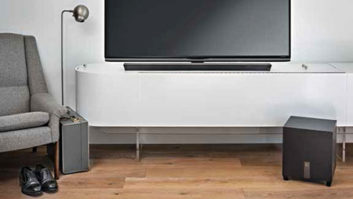Just a few months ago, in January, Sound Research, working as an audio partner with HP, received a CES Innovation Award for the technology behind its OMEN X HDR soundbar, a “you have to hear it to believe it” ten-transducer, consumer soundbar optimized for gamers, built for music, and introduced as a package with HP’s new Emperium X OMEN 65-inch, 4k HDR display.
The Emperium Omen X HDR display received a lot of attention and early press in January as the showpiece of Nvidia’s efforts (in conjunction with HP and others) into Big Format Gaming Display, a new category launched in 2018 and focused on gamers and entertainment. It is not a TV; it’s a display. It features 384 backlighting zones, DCI-P3 color gamut, game-smoothing G-Sync technology, and a whopping 144 Hz refresh rate. It also comes with a built-in Nvidia Shield console.
The included soundbar (currently only available with the purchase of the $5000 display) also received laudatory initial press, mostly focused on its loudness and clarity. It includes 2x tweeters, 4x woofers, and 4x subwoofers, with 3x stereo amplifiers at 120 watts. It is housed in a custom-cut wood enclosure designed specifically to fit under the display, at the lowest weight feasible (about 17 pounds).
The sound is stunningly sharp, loud, crisp, detailed, and organic, all at the same time. The highs seem to hover above and outside the screen, with the stereo image reaching off the display nearly to the walls. The center is solid, there is no subwoofer necessary.
Weapons and transients pop, and footsteps and rumbles remain clearly defined in the low end. The dynamic range feels equivalent to the best feature film playback. There are only two modes, in an effort to keep it simple: Gaming and Music. Internally, the speaker outputs switch when in Music mode, accommodate the shrinkage in dynamic range. In Music mode, the inner pair are subwoofers; in Gaming mode, the inner speakers are bandwidth-limited sub-plus-voice speakers.
Residential Systems got the opportunity to talk with the developers of the soundbar prior to CES, so as much as this is an early review of the OMEN X audio playback, it’s also a look at how pro and consumer audio developments often feed off of each other.

The connection between the two is Tom Paddock, founder of Sound Research. As a young engineer fresh out of San Jose State, he employed DSP and resynthesis—primitive and low-bitrate at the time—in developing a pickup that went down to 14 Hz and matched The Beam, Mickey Hart’s legendary 8-foot, 13-string, guitar-like sound generator that could reproduce low frequencies and loudness like nothing else on the planet. It matched the Grateful Dead’s Meyer Sound system, both in-studio and onstage.
Forty years later Paddock employed DSP, matched to current materials science and transducer technologies, in creating wide-dynamic range, 105 dB stereo playback with minimum distortion and vibration, to make audio sound better at home, whether for games, movies or music.
Partnerships and Playback
If Mickey Hart was the most influential artist in Paddock’s and Sound Research’s development, it was Intel that became the company’s most important technology partner, leading to the development of a sister company, Sonic Focus, in the late 1990s.
In 2003, Sonic Focus partnered with Intel to create Intel Audio Studio, which enhanced low-bitrate movie, music, and voice content and also created 7.1 channels from stereo compressed audio streams. For the next four years, Intel Audio Studio shipped with all Intel motherboards. A later partnership with Analog Devices built on that technology to produce the chipmaker’s SoundMax audio-enhanced chipsets.
In 2013, in conjunction with Intel, Sound Research introduced the SoundEdge ERT, an extended range 40mm transducer that first appeared in the ROAR series of small speakers, the HP AMP speaker-enabled printers, and was also leveraged in the 2017 CES Award-winning Dell XPS 27.
Around the same time, Sound Research had also partnered with Texas Instruments and its lead designer, Lars Risbo, who designed and developed the Smart Amplifier, later to be employed in Sound Research’s first real product with HP, and later incorporated into the OMEN X HDR soundbar.
“The Smart Amplifier is unique compared to standard Class D amplifiers, in that it is designed to limit the RMS wattage of the speaker to limit thermal problems in the voice coil, but to allow the peaks to come through,” Paddock explains. “If the peaks are rounded off with a compressor, the audio sounds thin and dull and unnatural because of waveform and time distortion. But in a crest-enhancing amplifier, if the peaks are allowed through, but the RMS or constant wattage is maintained, then the speaker sounds more natural. Smart amps are very popular now because of the crest-factor enhancement capability. TI pioneered the speaker-protecting hardware Smart Amplifier while Sound Research perfected the loudness-enhancing, software-based Reality Amplifier.”
Today, Smart Amplifier and Reality Amplifier form the basis for many of the company’s developments with HP, starting with the popular ROAR speaker in 2013 and later incorporated into the OMEN X soundbar. It’s an HP speaker, designed by Sound Research and the HP Audio Design Group, headed by Jon Dory. The same team developed a custom curved soundbar for professor Stephen Hawking for use on his wheelchair, tuned and optimized for his voice — the way he thought he should be hearing it. Much of that research was parlayed into the OMEN X HDR soundbar.
“The question every manufacturer asks is, ‘How loud can I make this product that I’m creating?’” Paddock laughs. “Everyone loves bass, and everyone wants loud. Some people also love clarity. Some people don’t know the difference. But everyone knows the difference between loud and not loud enough. The problem between loud and bass is that the louder you make a product, the less bass you can allow it to create. There’s a perfect relationship between loudness and bass and clarity, and it’s my company’s top goal to maintain low distortion with maximum loudness and superlative bass. It’s difficult to present all three of those criteria at the same time.
“We’ve been building products with HP for a decade, and the ROAR series was an indicator of our ability to enable HP with both tuning and speaker technology,” Paddock says. “We maintain maximum loudness using the Reality Amplifier. We maintain bass through the use of passive radiators and high-excursion transducers. And we limit distortion through proper materials design, proper enclosure design, and damping resonance. And Smart Amps provide speaker protection.
“Most soundbars are ABS plastic. The OMEN X HDR soundbar has a wooden enclosure and requires very little damping. Paul Kitano, our chief speaker ‘luthier,’ put together an optimized enclosure that is custom-cut out of wood — like building a guitar, but with a transducer inside an enclosure.”
The speaker bar was created in a modular fashion, with Kitano and team first developing a single speaker and a hyper-tuned passive radiator. The OMEN X HDR soundbar includes four of those modules to create width, depth, and bass—while limiting cabinet vibration. When one is listening, the stereo soundfield seems to fill a full 180 degrees, way above and beyond the screen.
Also read: Home Theater Sound’s Next Wave
Keep It Simple
There is no subwoofer; Paddock doesn’t believe in them for the nearfield environment, where portability and comfort reign supreme. Also, the OMEN X HDR soundbar measures down to 40 Hz. The bar itself was also designed to be idiot-proof. There are also only two inputs and two playback modes. It’s designed to be plug and play.
“The most brilliant designs are the simplest designs,” Paddock says. “The goal was to eliminate as many controls as possible because our feeling is that users don’t actually want as much control as they think they do. In the end, they want to turn the thing on and they want the product to work. Give them too many modes and they’ll often end up at the default setting anyway. We have a Gaming Mode for games and movies, with an enhanced center image for voice and narration, and a Music mode, which is left-right and what you would expect.
“Likewise, we originally had three inputs on the OMEN X HDR soundbar — HDMI, optical, and analog,” he continues. “I happen to think that HDMI on speaker bars is a bad idea for a variety of reasons, mostly involving changes in protocol and the introduction of new television sets and components that don’t conform. We found ourselves using the analog input more than the others, so we decided to build an excellent analog circuit using a Cirrus 105dB A-to-D. It was good enough that we decided we didn’t need a digital input. Everything that works with analog headphones should work with the speaker. Gamers primarily use headsets, primarily wired headsets. So we built a spec for the speaker bar that would match a set of headphones. And it always works!”
Simple to use and quality in every detail. And there is much more to come, including consumer tuning and calibration tools, again, made simple. Hopefully, it will some day be offered as a standalone bar. The modules are in place, the customization for immersive playback seems a no-brainer. We shall see.



